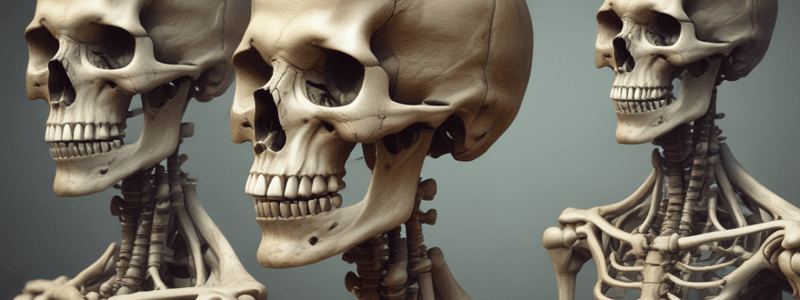Podcast
Questions and Answers
What are the two ways in which aging affects bone connective tissue?
What are the two ways in which aging affects bone connective tissue?
The two ways are: 1) Decreased tensile strength of bone due to reduced protein synthesis by osteoblasts, and 2) Bone demineralization, leading to loss of calcium and other minerals.
What is the condition characterized by a reduction in bone mass sufficient to compromise normal function?
What is the condition characterized by a reduction in bone mass sufficient to compromise normal function?
Osteoporosis
At what age does osteoblast activity decline, leading to bone mass reduction?
At what age does osteoblast activity decline, leading to bone mass reduction?
35-40 years of age
Which bones are most affected by bone mass reduction in older individuals?
Which bones are most affected by bone mass reduction in older individuals?
Why do women lose more skeletal mass than men every decade?
Why do women lose more skeletal mass than men every decade?
What are the risk factors for osteoporosis?
What are the risk factors for osteoporosis?
What is the name of the condition characterized by a poverty of bone mass?
What is the name of the condition characterized by a poverty of bone mass?
Why are Caucasian women more prone to osteoporosis?
Why are Caucasian women more prone to osteoporosis?
What are the three reasons why postmenopausal women are at a higher risk of developing osteoporosis?
What are the three reasons why postmenopausal women are at a higher risk of developing osteoporosis?
Why do cancer treatments increase the risk of developing osteoporosis?
Why do cancer treatments increase the risk of developing osteoporosis?
How do astronauts experience an increased risk of developing osteoporosis?
How do astronauts experience an increased risk of developing osteoporosis?
What is the primary goal of osteoporosis treatment, and how can it be achieved?
What is the primary goal of osteoporosis treatment, and how can it be achieved?
What is the role of calcium supplements with vitamin D in maintaining bone health?
What is the role of calcium supplements with vitamin D in maintaining bone health?
How do bisphosphonates work to slow the progression of osteoporosis?
How do bisphosphonates work to slow the progression of osteoporosis?
What hormone deficiencies contribute to the reduction in bone mass with age?
What hormone deficiencies contribute to the reduction in bone mass with age?
What is the significance of a DEXA scan in determining bone density?
What is the significance of a DEXA scan in determining bone density?
Flashcards are hidden until you start studying
Study Notes
Effects of Aging on Bone Structure
- Aging affects bone connective tissue in two ways: decreased tensile strength due to reduced protein synthesis by osteoblasts, and demineralization (loss of calcium and other minerals) leading to brittle and susceptible bones.
- Bones of the skeleton become thinner and weaker, resulting in osteopenia (insufficient ossification), a condition that affects all people to some extent.
- This reduction in bone mass may begin as early as 35-40 years of age, when osteoblast activity declines, while osteoclast activity continues at previous levels.
Osteoporosis
- Osteoporosis is a disease characterized by reduction in bone mass sufficient to compromise normal function.
- It leads to weakened bones prone to fracture, with the most common fracture sites being the wrist, hip, and vertebral column.
- Risk factors for osteoporosis include advanced age, especially in Caucasian women, family history, smoking, sedentary lifestyle, and postmenopausal estrogen deficiency.
- Astronauts are also at greater risk due to the lack of gravity in space reducing mechanical stress on bones.
Prevention and Treatment of Osteoporosis
- Young adults should maintain good nutrition and physical activity to ensure adequate bone density.
- Weight-bearing activities such as weight training, running, and walking have the greatest impact on preserving bone density.
- Calcium supplements with vitamin D help maintain bone health, but do not stimulate new bone growth.
- Medical treatments involve slowing the rate of bone loss and attempting to stimulate new bone growth, with bisphosphonates being prescribed to slow the progression of osteoporosis.
Factors Contributing to Osteoporosis
- Decreased hormone levels, including growth hormone, estrogen, and testosterone, contribute to reduction in bone mass with age.
- Women are more likely to develop osteoporosis due to lower initial bone mass, earlier and faster bone loss, and postmenopausal estrogen deficiency.
Studying That Suits You
Use AI to generate personalized quizzes and flashcards to suit your learning preferences.



